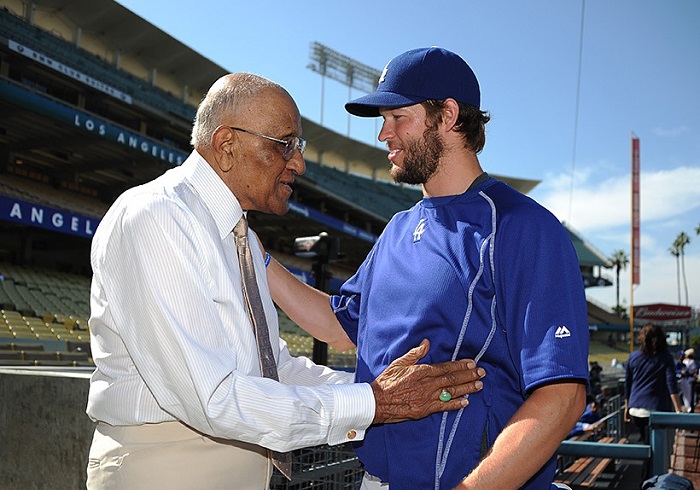* * *
1958
The Dodgers first season in Los Angeles was a disappointing one for excited Los Angeles baseball fans and many of the team’s star players, none more so than stalwart right-hander Don Newcombe.
After starting the Dodgers inaugural season in Los Angeles with a win-loss record of 0-6 and a 7.86 ERA, the (then) 32-year-old Madison, NJ native and beloved seven-year Brooklyn Dodger was traded to the Cincinnati Red Legs on June 15, 1958 for first baseman Steve Bilko, relief pitcher Johnny Klippstein, and minor league pitchers Art Fowler and Charlie Rabb (no Baseball_Reference record).
Newcombe turned around his season with the Red Legs with a record of 7 – 7, and a 3.85 ERA. The following season (1959) ‘Newk’ became the ace of the Red Legs pitching staff, with a 3.16 ERA and a record of 13 – 8, including 17 complete games.

The 30-year old Klippstein pitched well for the Dodgers as an innings-eating reliever that season (3.80 ERA), but the wheels fell off in the 1959 regular season with a 5.91 ERA. Bilko and Fowler were disappointments for the Dodgers, and Rabb never made it to the majors.
All-in-all, not one of then Dodgers general manager Buzzie Bavasi’s better trades, sending away Newcombe for very little in return to the Los Angeles team. But Bavasi would redeem himself in future acquisitions, starting in 1959.
* * *
1959
The team was woeful in their first season as the Los Angeles Dodgers, finishing seventh in the National League. ‘The Boys of Summer’ were aging: Pee Wee Reese was 39-years old and shared shortstop with Don Zimmer; right fielder Carl Furillo was 36 and only played in 122-games; first baseman Gil Hodges was 34; Duke Snider was only 31, but a knee injury limited him to only 106 games played; and, a January 28, 1958 car accident had left catcher and team leader Roy Campanella a quadriplegic. The team needed an infusion of talent and youth.
The Dodgers looked internally for talented youth, including pitchers Larry Sherry (age 23) and Stan Williams (22); and, outfielders Don Demeter (24) and Ron Fairly (20). But the team needed additional talent from outside the organization if they were to compete for the National League pennant in 1959.
Bavasi’s first major acquisition for that season’s roster was outfielder Wally Moon and minor league pitcher Phil Paine in return for outfielder Gino Cimoli on December 4, 1958. Moon had been a star for the St. Louis Cardinals from his rookie season in 1954 (that year’s NL rookie of the year) but had slumped most of 1958, batting only .238 with 7-home runs. Adjusting his swing to take advantage of the short left field distance at the LA Memorial Coliseum (a mere 250 feet down the left-field line with a 40 ft. high screen), Moon batted .302/.394/.495/.890; 19-home runs; a NL-leading 11-triples; 93 runs scored; with 74 RBI in the regular season.
On April 2, 1959, Bavasi made a seemingly minor trade, reacquiring 26-year old Maury Wills on a conditional deal with the Detroit Tigers. The Dodgers had released Pee Wee Reese in December but had shortstops Don Zimmer and Bob Lillis on the roster, so Wills appeared to be middle infield roster depth playing for the Triple-A Spokane Indians. But fate interceded. Wills slashed .313/.387/.391/.778 with 25-stolen bases in 30-attempts for Spokane, while the combination of Zimmer and Lillis hovered around the Mendoza line. Wills became the Dodgers shortstop, spark plug, and team leader by example.
Just before the midpoint of the 1959 regular season, Bavasi made another trade, sending third baseman Dick Gray to the St. Louis Cardinals for right-hand-hitting outfielder Chuck Essegian and minor league pitcher Lloyd Merritt. Initially, Essegian was assigned to the Spokane Indians, but after slashing .295/.354/.528/.883 with 9-home runs in 48-games, he was promoted to the majors where he batted .304/.360/.500/.860 in 24-games. But Essegian saved his best for the 1959 World Series, where he hit 2-pinch hit home runs in three at-bats.
The Dodgers were once again World Champions, this time for the City of Angels.
We will explore other notable trades in the future.
Stay tuned…
* * * * * *




 April 15th, 2020 at 10:00 am
April 15th, 2020 at 10:00 am  by 0799291000348
by 0799291000348  Posted in
Posted in 
